 W
WBank Panic is an arcade shooter game developed by Sanritsu Denki and released by Sega in 1984. Bally-Midway manufactured the game in the US. The player assumes the part of an Old West sheriff who must protect a bank and its customers from masked robbers.
 W
WThe Black Onyx is a 1984 role-playing video game released in Japan, developed by Bullet-Proof Software, with development led by Henk Rogers. It was originally released for the NEC PC-8801, and ported to several other platforms. The Famicom version featured completely redesigned gameplay, a new map, and was retitled Super Black Onyx (スーパーブラックオニキス). The Game Boy Color port was developed by Atelier Double and published by Taito. The Game Boy Color port added enhanced visuals and included an option to play through the game with the original game's visual style.
 W
WBomb Jack is a platformer arcade game released in 1984 by Tehkan, and later ported to various home systems. The game was a commercial success for arcades and home computers. It was followed by several sequels: the console and computer title Mighty Bomb Jack, the arcade game Bomb Jack Twin, and Bomb Jack II which was licensed for home computers only.
 W
WBorderline is a vertically scrolling shooter-maze game released by Sega as an arcade game in 1981. The player controls a jeep and has to destroy enemy refineries. There are four stages with different gameplay. The first stage plays like a vertically scrolling shooter. In the second stage, the player maneuvers his Jeep through underbrush, and enemies can only follow on its path, a concept later found in Namco's Dig Dug (1982).
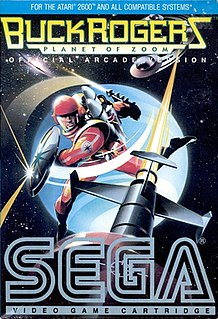 W
WBuck Rogers: Planet of Zoom, known as Zoom 909 in Japan, is a pseudo-3D rail shooter video game released in arcades by Sega in 1982. The game is a forward-scrolling rail shooter where the player controls a spaceship in a third-person perspective, adapting the three-dimensional perspective of Sega's earlier racing game Turbo (1981) for the space shoot 'em up genre. It used the Buck Rogers license, referencing the space battles, though Buck himself is never seen.
 W
WChack'n Pop is an platform arcade game developed and released by Taito in 1984. In the game, the player controls a small yellow creature, Chack'n, with the objective being to retrieve hearts from a cave, all while avoiding the enemies contained within them. Chack'n also has the ability to deploy bombs, which can kill said enemies, which can bring bonuses depending on if the all or none of the enemies have been killed.
 W
WChampion Baseball is an arcade baseball video game developed by Alpha Denshi and published by Sega in March 1983. It was a sophisticated sports video game for its time, displaying a split-screen format, with the playfield viewed from two camera angles, one from the outfield and another close-up shot of the batter and pitcher, while giving players the option of selecting relief pitchers or pinch hitters and with an umpire looking on attentively to make the game calls. The game also had digitized voices for the umpire, and individual player statistics. A person could play for hours with one token providing they tied scores at the 9th and further innings.
 W
WChampion Boxing is a 1984 boxing sports video game developed and published by Sega for the Sega SG-1000, and later ported to the arcades, only in Japan and Europe. It was Sega-AM2 founder and leader Yu Suzuki's debut creation, as well as that of Rieko Kodama. In 1985, a successor of Champion Boxing titled Champion Pro Wrestling was released in the arcades, and ported to the SG-1000 and the MSX home computer the same year. However, this is a professional wrestling game instead of a boxing game.
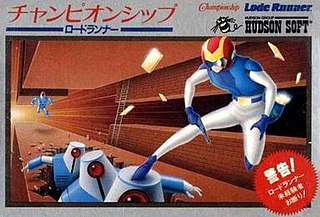 W
WChampionship Lode Runner is a sequel to the 1982 puzzle-platform game Lode Runner. It was released in 1984 for the Apple II, Commodore 64, and IBM PC, then ported to the Atari 8-bit family, Famicom, SG-1000, and MSX. Mostly the same as Lode Runner, Championship Lode Runner has levels that are much more challenging. Unlike the original, it does not include a level editor.
 W
WChoplifter is military themed scrolling shooter developed by Dan Gorlin for the Apple II and published by Broderbund in 1982. It was ported to the Atari 8-bit family the same year and also to the VIC-20, Commodore 64, Atari 5200, ColecoVision, MSX, and Thomson computers.
 W
WCircus Charlie is an action game originally published in arcades by Konami in 1984. The player controls a circus clown named Charlie in six different circus-themed minigames. It was released for MSX in the same year, followed by ports to the Famicom in 1986 by Soft Pro and the Commodore 64 in 1987.
 W
WCongo Bongo,, also known as Tip Top, is an isometric platform game released by Sega for arcades in 1983. The game includes a ROM that contains a message indicating it was likely coded at least in part by the company Ikegami Tsushinki. The game is viewed in an isometric perspective, like Sega's previous game Zaxxon (1981).
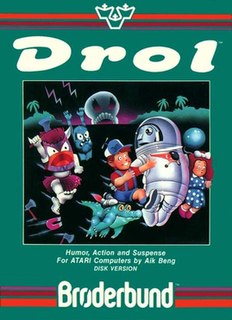 W
WDrol is a video game published by Broderbund in 1983. It was originally written for the Apple II by Benny Aik Beng Ngo, and was ported to the Commodore 64 and Atari 8-bit family. It appeared for the SG-1000 in 1985 and Amiga in 1991.
 W
WElevator Action is a platform-shooter game released in arcades by Taito in 1983. The player assumes the role of Agent 17, a spy infiltrating a 30 story building filled with elevators and enemy agents who emerge from closed doors. The goal is to collect secret documents from specially marked rooms, then escape the building. It runs on the Taito SJ System arcade system.
 W
WExerion is a shoot 'em up video game developed and published by Jaleco for arcades in February 1983, and licensed to Taito for manufacture and distribution of the game in North America. The player controls a starship and must fire at enemies on the screen while avoiding projectiles. The game uses a pseudo-3D scrolling background, giving a sense of depth, and the player's ship has a sense of inertia while it is being controlled with the joystick.
 W
WFlicky is a platform game developed by Sega and released in arcades in May 1984. It was licensed to Bally Midway for distribution in the United States. In Flicky, the player controls the eponymous blue bird and must gather all the small birds called Chirps in each round and bring them safely to the exit. There are cat and lizard enemies which can disperse the Chirps and kill the player, but Flicky can use items on the playing field to protect herself and the Chirps from danger.
 W
WGalaga is a 1981 fixed shooter arcade game developed and published by Namco. In North America, it was released by Midway Manufacturing. It is the sequel to Galaxian (1979), Namco's first major video game hit in arcades. Controlling a starship, the player is tasked with destroying the Galaga forces in each stage while avoiding enemies and projectiles. Some enemies can capture a player's ship via a tractor beam, which can be rescued to transform the player into a "dual fighter" with additional firepower.
 W
WGirl's Garden is an action game developed and published by Sega for the SG-1000 console in 1984 or 1985. The game follows a girl as she gathers flowers to win the love of a boy. It was the debut work of Sega programmers Yuji Naka and Hiroshi Kawaguchi. Naka went on to co-create the Sonic the Hedgehog series and Kawaguchi would later compose music for popular Sega arcade games.
 W
WGuzzler is a maze video game developed and manufactured by Tehkan and licensed to Centuri for US distribution in 1983. It was released as an arcade conversion kit, including a new marquee and control panel, then ported to the SG-1000 console. In Guzzler, the player controls a creature who can drink water from puddles, then extinguish fires and monsters spawned from those fires.
 W
WH.E.R.O. is a video game written by John Van Ryzin and published by Activision for the Atari 2600 in March 1984. It was ported to the Apple II, Atari 5200, Atari 8-bit family, ColecoVision, Commodore 64, MSX, and ZX Spectrum. The player uses a helicopter backpack and other tools to rescue victims trapped deep in a mine. The mine is made up of multiple screens using a flip screen style.
 W
WHang-On is an arcade racing game released by Sega in 1985 and later ported to the Master System. In the game, the player controls a motorcycle against time and other computer-controlled bikes. It was one of the first arcade games to use 16-bit graphics and utilizes the Super Scaler arcade system board, created with design input from Yu Suzuki, as technology to simulate 3D effects. The deluxe cabinet version also introduced a motion-controlled arcade cabinet, where the player's body movement on a large motorbike-shaped cabinet corresponds with the player character's movements on screen.
 W
WHyper Sports, known in Japan as Hyper Olympic '84, is an Olympic-themed sports video game released by Konami for arcades in 1984. It is the sequel to 1983's Track & Field and features seven new Olympic events. Like its predecessor, Hyper Sports has two run buttons and one action button per player. The Japanese release of the game sported an official license for the 1984 Summer Olympics.
 W
WJames Bond 007 is horizontally scrolling shooter published in 1983 by Parker Brothers for the Atari 2600, Atari 5200, Atari 8-bit family, Commodore 64, and ColecoVision. It was distributed in Japan by Tsukuda Original for the SG-1000. It was the first video game based on James Bond to be given a worldwide release.
 W
WLode Runner is a 2D puzzle-platform game, developed by Douglas E. Smith and published by Broderbund in 1983. Its game-play mechanics are the same as in Space Panic from 1980. The player controls a character who must collect all the gold pieces in a level and get to the end while being chased by a number of enemies. It is one of the first games to include a level editor.
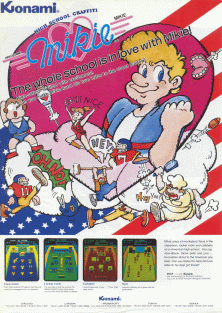 W
WMikie, known as Shinnyū Shain Tōru-kun in Japan, is an arcade video game developed and released by Konami in 1984. The object of the game is to guide a student named Mikie around the school locations to collect hearts which make up a letter from his girlfriend while being chased by members of the school staff. In Japan, the game's setting was changed an office in order to avoid controversy, while the original version of the game was released internationally. Centuri distributed the game in North America.
 W
WMonaco GP is an arcade racing game released by Sega in 1979. One of the last Sega games to use TTL chips instead of a microprocessor CPU, the game has players race against a clock and pass rival racers while attempting to earn points driving through five areas.
 W
WMotoRace USA is a racing video game developed and released in arcades by Irem in 1983. In North America, it was released by Williams Electronics. The player controls a racer who must travel on a motorcycle from Los Angeles to New York City.
 W
WN-Sub (N-サブ) is a 1980 arcade game developed and published by Sega. N-Sub was later ported by Sega as a launch game for the SG-1000 in 1983 though as with all SG-1000 games, it only saw a release in Japan and PAL regions.
 W
WPitfall! is a platform video game designed by David Crane for the Atari 2600 and released by Activision in 1982. The player controls Pitfall Harry and is tasked with collecting all the treasures in a jungle within 20 minutes. The world consists of 255 screens which are horizontally connected in a flip screen manner. Each screen has one or more hazards: quicksand, tarpits, rolling logs, crocodiles, snakes, scorpions, campfires, and swinging vines.
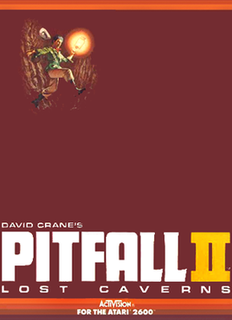 W
WPitfall II: Lost Caverns is a platform video game originally released for the Atari 2600 by Activision in 1984. It is the sequel to Pitfall! (1982). Both games were designed and programmed by David Crane and star jungle explorer Pitfall Harry. Pitfall II's major additions are a much larger world with vertical scrolling, swimmable rivers with deadly eels, music, and balloons for floating between locations.
 W
WRock n' Bolt is a puzzle video game developed by Action Graphics and published in 1984 by Activision for ColecoVision, Commodore 64, MSX, and SG-1000.
 W
WThe Secret of Bastow Manor is a 1983 graphical adventure game for the Commodore VIC-20 and Commodore 64 home computers. The Commodore 64 version is formally titled The Secret of Bastow Manor 64.
 W
WSega Ninja, originally released as Ninja Princess in Japan, is a 1985 arcade action game released by Sega. The game features Princess Kurumi, the titular female ninja, battling enemies using throwing knives and throwing stars. The game was originally released in arcades as Ninja Princess in Japan and Sega Ninja internationally. The game is essentially an early run-and-gun shooter, but in contrast to most later games in the genre, Ninja Princess has a feudal Japan setting with a female ninja protagonist who throws shuriken and knives.
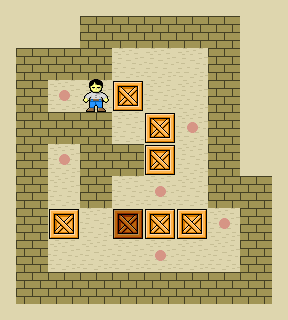 W
WSokoban is a puzzle video game genre in which the player pushes crates or boxes around in a warehouse, trying to get them to storage locations.
 W
WSpace Invaders is a 1978 shoot 'em up arcade game developed by Tomohiro Nishikado. It was manufactured and sold by Taito in Japan, and licensed by the Midway division of Bally for overseas distribution. Space Invaders was the first fixed shooter and set the template for the shoot 'em up genre. The goal is to defeat wave after wave of descending aliens with a horizontally moving laser to earn as many points as possible.
 W
WStar Force, released in North America by Video Ware in the arcades as Mega Force, is a vertical-scrolling shooter computer game released in 1984 by Tehkan.
 W
WTrack & Field, also known as Hyper Olympic in Japan and Europe, is a 1983 Olympic-themed sports video game developed by Konami for arcades. The Japanese release sported an official license for the 1984 Summer Olympics. In Europe, the game was initially released under the Japanese title Hyper Olympic in 1983, before re-releasing under the US title Track & Field in early 1984.
 W
WTranquilizer Gun is a multi-directional shooter arcade game released in 1980 by Sega.
 W
WWonder Boy is a 1986 platform game published by Sega and developed by Escape. Originally designed for arcades, it was later ported to the SG-1000, Mark III/Master System and Game Gear video game consoles by Sega, and to the ZX Spectrum, Commodore 64 and Amstrad CPC home computers by Activision. The game is also known as Super Wonder Boy for its Sega Mark III release in Japan and Revenge of Drancon for its Game Gear release in North America. A high definition remake of the game, titled Wonder Boy Returns, was developed by CFK and released on Steam on October 12, 2016.
 W
WZaxxon is an isometric shooter arcade game, developed and released by Sega in 1981, in which the player pilots a ship through heavily defended space fortresses. Japanese electronics company Ikegami Tsushinki is also credited for having worked on the development of the game.